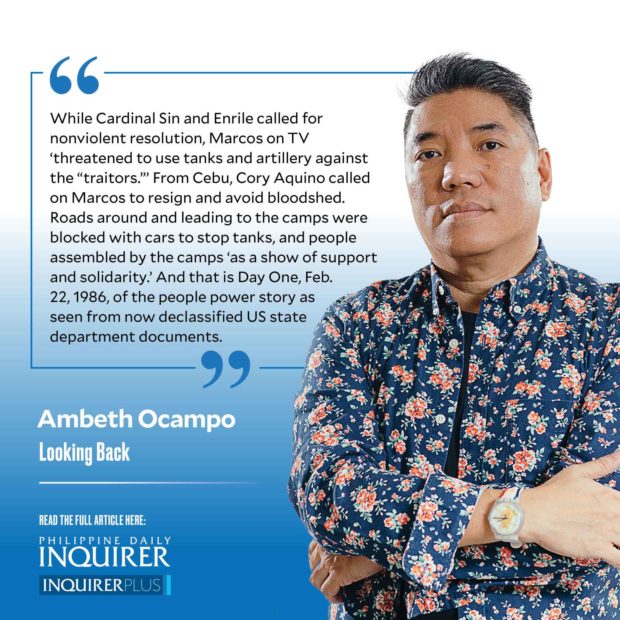US situation reports on Edsa 1986
Some years ago, colleagues, who had been at Edsa in 1986 and experienced people power firsthand, complained that their students did not seem to know or care about it. I advised them to mind their age and accept that their students were born long after Edsa. The long-staying president they grew up with was not Ferdinand E. Marcos like us, but Gloria Macapagal Arroyo. For students occupied with the present on their smartphones, Edsa and martial law is not a fading memory; it is far back in time, like the Stone Age.
While I watched Edsa 1986 unfold (from TV, phone calls, neighborhood gossip, and other sources), my reconstruction of events today will not be complete without going through primary sources: newspapers, TV reports, biographies, autobiographies, reminiscences, memoirs, and interviews of the principal players. The University of Michigan Library has provided me with yet another primary source: declassified US state department documents of the period. A snap election preceded the events of Edsa, and the US Embassy was monitoring the results and transmitting these to Washington. For example, as of 9 p.m. of Feb. 12, 1986, Comelec figures had Marcos leading with 7,032,905 votes, followed by: Corazon Aquino with 6,384,364, Tolentino 6,707,515 votes, and Laurel 6,237,496 votes. Namfrel figures were not yet available. Figures were broken down by region, narrowed down to the two leading contenders Marcos and Aquino.
By Feb. 22, 1986, another series of situation reports replaced the election watch. These reports, classified as “secret,” were sent by the US Embassy in Manila to Washington, with copies furnished other posts on a need to know basis. Philippine Task Force Situation Report No. 1 as of 10:30 a.m. Feb. 22, 1986 (Eastern Standard Time) narrated the defection of Juan Ponce Enrile and Fidel Ramos as “the first major public fracture within the Marcos government.”
“Defense Minister Enrile and Deputy Armed Forces Chief of Staff Lt. Gen. Ramos have announced in Manila that they can no longer recognize that President Marcos has a mandate of the people. Enrile stated that he personally knew of 300,000 fraudulent votes which had been manipulated in his region of Northeast Luzon. He said his conscience would not let him continue…”
The report states that Enrile and Ramos were in defense headquarters in Camp Aguinaldo, with loyal troops, and access to the press. Cory Aquino and Doy Laurel were not involved in this turn of events, as they were in Cebu attending a massive rally. Contrary to rumors that Marcos had holed up in Ilocos Norte, he gave a press conference in Malacañang regarding an assassination plot against him, and accused Enrile and Ramos of treason. There were no reports of fighting and that “respective loyalties of key troops will be critical.”
Four hours later, Situation Report No. 2 said that Ramos and Enrile had moved from Camp Aguinaldo to Camp Crame, and that an estimated 20,000 people, many bringing food for the rebel soldiers, had heeded the call of Manila Archbishop Jaime Cardinal Sin to lend their support by going to Edsa. Marcos, on TV, blamed the opposition for the defection of Enrile and Ramos. He said, “Whether the United States supported and encouraged the affair is something that we would like to find out.”
Marcos got the answer to his question hours later, when the White House issued a statement expressing “concerns that recent presidential elections were marred by fraud, perpetrated overwhelmingly by the Ruling Party, so extreme as to undermine the credibility and legitimacy of the election and impair the capacity of the Government of the Philippines with a growing insurgency and a troubled economy.”
While Cardinal Sin and Enrile called for nonviolent resolution, Marcos on TV “threatened to use tanks and artillery against the ‘traitors.’” From Cebu, Cory Aquino called on Marcos to resign and avoid bloodshed. Roads around and leading to the camps were blocked with cars to stop tanks, and people assembled by the camps “as a show of support and solidarity.”
And that is Day One, Feb. 22, 1986, of the people power story as seen from now declassified US state department documents.
——————-
Comments are welcome at aocampo@ateneo.edu





















